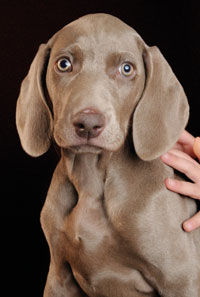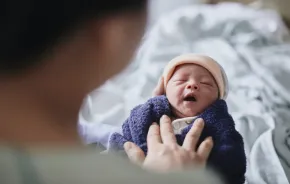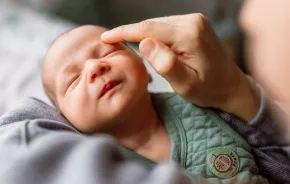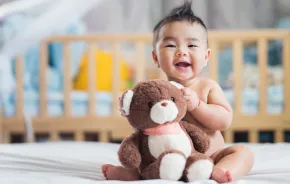 You've just found out you're pregnant, and well-meaning friends are already telling you that Fido and Fluffy have got to go. Old wives' tales abound about babies and pets, from the ridiculous "a cat will suck the baby's breath" to the plausible "the baby will develop allergies." The truth is, babies and pets can coexist -- and, as research shows, often benefit from doing so.
You've just found out you're pregnant, and well-meaning friends are already telling you that Fido and Fluffy have got to go. Old wives' tales abound about babies and pets, from the ridiculous "a cat will suck the baby's breath" to the plausible "the baby will develop allergies." The truth is, babies and pets can coexist -- and, as research shows, often benefit from doing so.
For parents of a new baby, life will change dramatically as you adjust to the new routines and needs of an infant. The same holds true for the family pet. If your pet has never encountered an infant, it's a good idea to introduce the animal to one long before baby arrives. If possible, invite friends with babies to spend an afternoon at your home, exposing your pet to those special sounds and smells that only babies make. If baby's room will be off limits to your pet, start restricting access now, so the animal does not equate the new rules with the baby. A baby gate will keep out most dogs; a screen door will deter cats.
Animals need not be restricted for fear of allergic reactions. A study published in the Journal of the American Medical Association in 2002 found that children raised with two or more pets had a reduced risk of developing allergies by 50 percent or more. And, according to the study, babies are just as likely to be allergic to dust or mold. So if symptoms persist, a pediatric allergist should be consulted before automatically getting rid of a pet.
Preparing for baby's arrival
Before baby arrives, start to pull back on the time spent with your pet to accustom it to a baby-centric schedule. Take your pet to the veterinarian for a check-up and make sure vaccinations are up to date. Spay or neuter your pet to reduce the possibility of aggression. Daily brushing will minimize pet hair around the house, and trimmed nails help avoid accidental scratches. If a different family member will be assuming responsibility for the pet after the baby's arrival, start that routine as early as possible.
Let the pet sniff and explore a blanket or clothing that has been in contact with the baby before he or she comes home from the hospital. If mom has been the main pet caregiver, it's helpful to have her enter the house without the babe in arms, so she can greet the pet one on one. Introduce the baby cautiously, but without fear. Praise the pet for appropriate behavior.
Dogs and cats are the pets most affected by the addition of a new baby -- and vice versa. With each, there are specifics that can help make the transition go more smoothly.
The canine factor
If you have never formally trained your dog, enroll in a basic obedience class immediately. If your older dog went through the process years ago, take a refresher course. Nancy Peterson, issues specialist with The Humane Society of the United States, notes, "Training and socialization are the important factors. The pet needs to be exposed to all kinds of things so they can learn not to be frightened." Training gives you better control over your dog. Commands such as "sit," "stay," "off," and "leave it" will be invaluable in helping your dog learn proper behavior around your baby.
Dogs are pack animals and very aware of their position. The new baby will knock your dog down a peg, so it's important to use positive reinforcement when training and disciplining your dog. If your dog is fearful, easily excited, or exhibits other undesirable traits, such as food aggression, you should consider a few sessions with an animal behaviorist. These certified specialists can be essential in helping your dog adjust to its change in status. Peterson recommends finding a behaviorist who will visit your home and observe the dog on its own turf. Steve Ramey, manager of the Animal Behavior Society, says, "Your veterinarian is your best resource for finding a behaviorist as he or she is most likely to know who is reputable in your area."
Dog toys often resemble baby toys. A dog that loves to chew up its own stuffed animals will want baby's toys as well and won't know the difference. Before your baby arrives, switch to dog-specific toys, such as a Kong® or Nylabone®, to help avoid confusion. A dog that responds to "leave it" can be taught which toys are off limits.
The feline factor
Cats come with their own set of baby-specific issues. Consummate heat-seekers, they will be attracted to a warm baby in a cozy crib. And although "breath sucking" is not an issue, it's best to restrict the cat's access to the baby's room without adult supervision. It's also smart to apply double-sided tape to the surfaces in the baby's room, as cats avoid sticky surfaces and will steer clear.
The commotion that comes with a new baby can be stressful to some cats and cause them to exhibit undesirable behavior, such as spraying urine or hiding. Feliway®, a product available at vets' offices that is similar to a plug-in air freshener, emits a "neutral cat pheromone" that can help calm a stressed cat.
As baby grows
Once your infant is mobile, new precautions are necessary.Dogs will camp out under a highchair hoping for dropped food -- great for clean-up, but be wary of dogs that are able to jump or stand high enough to reach food in baby's fingers. It's essential that your dog be trained to respond to "off" in this context. Dogs also need to be trained not to snatch food or toys from a toddler's grasp.
Pet food and water bowls should be kept out of baby's reach -- and the same goes for litter boxes. If you have a sandbox or sensory table for your baby or toddler, it should be kept covered when not in use.
Adult supervision is a necessity when babies and pets interact. Babies have a natural affinity for animals and will instinctively grab, yank or poke, which could result in a warning nip or scratch. Teach the baby to treat the pet gently, and a lifelong friendship will result.
Worth the effort
Gail Melson, Ph.D., professor emeritas in the Department of Child Development and Family Studies at Purdue University, makes the case for babies and pets coexisting. "Animals are a lively, living presence in a house ... adding a very rich source of interest," says Melson. She notes that tactile stimulation is also a plus. "You have that very soft fur for contact comfort that is very pleasing to babies."
In her book Why the Wild Things Are: Animals in the Lives of Children, Melson stresses the benefits of pets on a child's emotional development. "Many animals can form, very early, an attachment with a very young child and the child can reciprocate that in return. ... the pet provides play opportunities at the child's level and gives the child leadership opportunities -- especially with dogs."
The reward is a child who grows into an empathetic adult. Melson notes, "Research suggests that caring for animals is a key childhood experience. It's especially true as family sizes have become smaller. Without always having a baby around, there aren't a lot of opportunities for children to practice nurturing -- trying to help another, more vulnerable creature along."
In the long run, it will be worth the effort to help your pet adjust to the new family member. Your pet and your child will thank you for it.
Andrea Leigh Ptak has written about the human-animal bond for Delta Society's Interactions magazine, American Girl and Stars & Stripes. She introduced her own baby to a household with two dogs and two cats 12 years ago, with successful results.
Babies and Pets Resources
- The Humane Society of the United States offers a downloadable brochure with advice on introducing your pet and new baby.
Dog Trainers
- Canine Behavior Center, Inc.
206-367-8071 Seattle/Lynnwood
425-488-0923 Bothell/Mill Creek
425-898-1341 Redmond/Kirkland
425-562-9170 Bellevue/Mercer Island
1-888-CANINE8 Marysville/Snohomish
1-888-226-4638 South King County - PAWS-ABILITIES Dog Training Center
1007 Industry Drive, Tukwila, 98188
425-277-3794 - AHIMSA Dog Training
902 N.W. 49th St., Seattle, WA 98107
206-718-5073
info@DoggieZen.com
Animal Behaviorists
- Animal Behavior Associates of Washington
- James C. Ha, Ph.D., Lynnwood, WA
425-697-5486
jcha@u.washington.edu - Animal Behavior Society
Features a directory of certified members and other resources.









